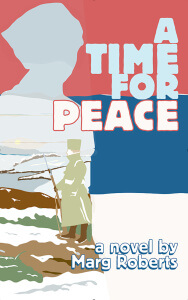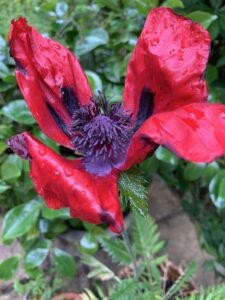A Time for Peace was published by Cinnamon Press in October 2016. Set during World War 1 in Serbia, in historical terms it describes an unusual event. Austria occupied Serbia in late 1914, and having fought and lost, Serbia’s King and government decided not only to leave the country themselves, but to take with them their future army – boys aged 15 – 17, not yet eligible for military service. The army was the future.
It was an arduous journey during the worst winter in living memory. Here, an extract from the diary of Ellen, an English volunteer who accompanied the cadets.
Today we only covered 6 miles, stopping outside Mitrovica. The road along the Ibar became difficult. Because of heavy rain and snow in the mountains, frequent landslides and mountain torrents flood its narrow, zig-zag route. … We’d no bread for 2 out of 6 days. All of us are tired and hungry.The boys are growing weaker. One of them has frost bite.
The army destroyed its guns, its weapons, anything that could be used by the enemy. Again in the words of the novel’s heroine.
From time to time, Ellen witnessed the destruction of vehicles. Two soldiers wearing gauntlets and sheepskin gilets doused a French limousine and several army vehicles with petrol. A gun-wielding private dashed up and down the road shouting, ‘Danger! Danger!’ It was amusing till the flames whooshed as they took hold. Yellow, green, orange and purple devoured what were once recognisable vehicles. The smell of petrol was followed by that of rubber and leather.
On the border between Serbia and Montenegro, the hero, Stefan, colonel of the fictional Sixth Army, describes the emotional leaving of their country, not knowing when or if they would ever return.
Stefan spent the rest of the morning organising the dismantling of the field howitzers. Units transported the barrels for burial in the forests behind the monastery. The wooden mounts and gun carriages were set alight, or tipped into the river. The breech and aiming devices were loaded onto animals and began the journey through the mountains…. Mid-morning a group of priests came to him. The populace would celebrate resistance, hold mass followed by burial rites for one symbolic gun. … Smoke darkened the afternoon sky. … Outside the cathedral’s west door, at the top of the steps in the centre of the open space, they positioned a French 75mm gun covered in holly, rosemary and ivy wreaths….
In all, 30,000 cadets and hundreds of its people left Serbia. Many perished. During wars we learn how much we yearn for peace.
References: Many thanks to Jan Wood and Rohan of Cinnamon Press who enabled me to have this novel published. This year is their 20th year so look them up. They publish poetry and fiction – voices that otherwise might not be heard.
Current Inspiration
White Ghosts – Katie Hale. An American writer who traces her maternal lines – finding surprises and shocks along the way. Her writing is vigorous and out of this world. She has a wonderful line about ‘a second skin’, which I encourage you to find in her poem, My Great Grandmother Crossing the State Border.
Miss Graham’s War – Celia Rees. Not an easy read in the sense that it’s set in the aftermath of Second World War. Enthralling and recommended.
Cuckoo in the Nest – Fran Hill. A moving read, which is a page turner with a light humorous touch.
I follow Yasmin Ali whose political assessments inform me, Wendy Pratt’s, Notes from the Margin on Substack, and also David Aaronovitch whose writing I dip into.
If you haven’t read A Time for Peace and would like a copy, free of charge, the first 10 readers who put their email address in the comment box, will be sent a copy by post.



Recent Comments